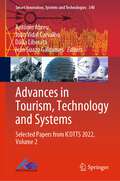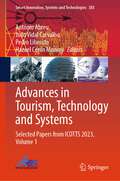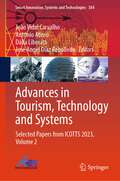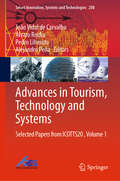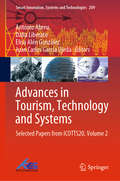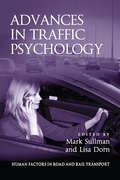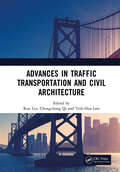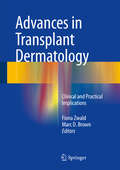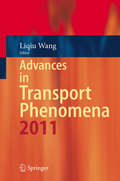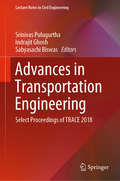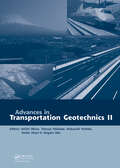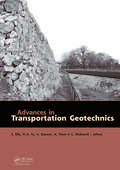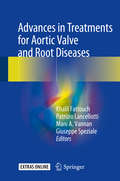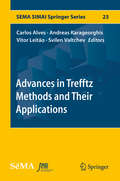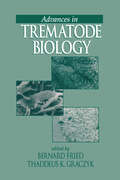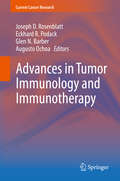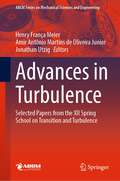- Table View
- List View
Advances in Tourism, Technology and Systems: Selected Papers from ICOTTS 2022, Volume 2 (Smart Innovation, Systems and Technologies #340)
by António Abreu Dália Liberato João Vidal Carvalho Iván Suazo GaldamesThis book features a collection of high-quality research papers presented at the International Conference on Tourism, Technology and Systems (ICOTTS 2022), held at University of Chile, Santiago de Chile, Chile, from 3 to 5 November 2022. The book is divided into two volumes, and it covers the areas of technology in tourism and the tourist experience, generations and technology in tourism, digital marketing applied to tourism and travel, mobile technologies applied to sustainable tourism, information technologies in tourism, digital transformation of tourism business, e-tourism and tourism 2.0, big data and management for travel and tourism, geotagging and tourist mobility, smart destinations, robotics in tourism, and information systems and technologies.
Advances in Tourism, Technology and Systems: Selected Papers from ICOTTS 2023, Volume 1 (Smart Innovation, Systems and Technologies #383)
by António Abreu Pedro Liberato João Vidal Carvalho Hazael Cerón MonroyThis book features a collection of high-quality research papers presented at the International Conference on Tourism, Technology and Systems (ICOTTS 2023), held at Anáhuac University, Bacalar, Mexico, from 2 to 4 November 2023. The book is divided into two volumes, and it covers the areas of technology in tourism and the tourist experience, generations and technology in tourism, digital marketing applied to tourism and travel, mobile technologies applied to sustainable tourism, information technologies in tourism, digital transformation of tourism business, e-tourism and tourism 2.0, big data and management for travel and tourism, geotagging and tourist mobility, smart destinations, robotics in tourism, and information systems and technologies.
Advances in Tourism, Technology and Systems: Selected Papers from ICOTTS 2023, Volume 2 (Smart Innovation, Systems and Technologies #384)
by António Abreu Dália Liberato João Vidal Carvalho José Angel Díaz RebolledoThis book features a collection of high-quality research papers presented at the International Conference on Tourism, Technology and Systems (ICOTTS 2023), held at Anáhuac University, Bacalar, Mexico, from 2 to 4 November 2023. The book is divided into two volumes, and it covers the areas of technology in tourism and the tourist experience, generations and technology in tourism, digital marketing applied to tourism and travel, mobile technologies applied to sustainable tourism, information technologies in tourism, digital transformation of tourism business, e-tourism and tourism 2.0, big data and management for travel and tourism, geotagging and tourist mobility, smart destinations, robotics in tourism, and information systems and technologies.
Advances in Tourism, Technology and Systems: Selected Papers from ICOTTS20 , Volume 1 (Smart Innovation, Systems and Technologies #208)
by Álvaro Rocha Pedro Liberato João Vidal de Carvalho Alejandro PeñaThis book features a collection of high-quality research papers presented at the International Conference on Tourism, Technology & Systems (ICOTTS 2020), held at the University of Cartagena, in Cartagena de Indias, Colombia, from 29th to 31st October 2020. The book is divided into two volumes, and it covers the areas of technology in tourism and the tourist experience, generations and technology in tourism, digital marketing applied to tourism and travel, mobile technologies applied to sustainable tourism, information technologies in tourism, digital transformation of tourism business, e-tourism and tourism 2.0, big data and management for travel and tourism, geotagging and tourist mobility, smart destinations, robotics in tourism, and information systems and technologies.
Advances in Tourism, Technology and Systems: Selected Papers from ICOTTS20, Volume 2 (Smart Innovation, Systems and Technologies #209)
by António Abreu Dália Liberato Elisa Alén González Juan Carlos Garcia OjedaThis book features a collection of high-quality research papers presented at the International Conference on Tourism, Technology & Systems (ICOTTS 2020), held at the University of Cartagena, in Cartagena de Indias, Colombia, from 29th to 31st October 2020. The book is divided into two volumes, and it covers the areas of technology in tourism and the tourist experience, generations and technology in tourism, digital marketing applied to tourism and travel, mobile technologies applied to sustainable tourism, information technologies in tourism, digital transformation of tourism business, e-tourism and tourism 2.0, big data and management for travel and tourism, geotagging and tourist mobility, smart destinations, robotics in tourism, and information systems and technologies.
Advances in Toxicology and Risk Assessment of Nanomaterials and Emerging Contaminants
by Liang-Hong Guo Monika MortimerThis book details the state-of-the-art methodological advances for delineating the toxicology and working mechanisms of nanomaterials, microplastics, fine aerosol particulates (PM2.5) as well as emerging organic pollutants. It also provides latest computational approaches for toxicity prediction and risk assessment of nanoscale materials which possess realistic chances to enter the environment and human organism. Written by leading scientists at the frontiers of environmental science and nanomedicine, this book is intended for both young researchers and experienced professionals working in the fields of environmental protection, human health and occupational safety, nanotechnology, material science and nanomedicine, as well as graduate students majoring in environmental and health sciences.
Advances in Traffic Psychology (Human Factors in Road and Rail Transport)
by Mark SullmanTraffic psychology is a rapidly expanding and broad field within applied psychology with a considerable volume of research activities and a growing network of academic strands of enquiry. The discipline primarily focuses on the behaviour of road users and the psychological processes underlying these behaviours, looking at issues such as cognition, distraction, fatigue, personality and social aspects, often delivering practical applications and educational interventions. Traffic psychology has been the focus of research for almost as long as the motor car has been in existence and was first recognised as a discipline in 1990 when the International Association of Applied Psychology formed Division 13: Traffic and Transportation Psychology. The benefits of understanding traffic psychology are being increasingly recognised by a whole host of organisations keen to improve road safety or minimise health and safety risks when travelling in vehicles. The objective of this volume is to describe and discuss recent advances in the study of traffic psychology, with a major focus on how the field contributes to the understanding of at-risk road-user behaviour. The intended readerships include road-safety researchers from a variety of different academic backgrounds, senior practitioners in the field including regulatory authorities, the private and public sector personnel, and vehicle manufacturers concerned with improving road safety.
Advances in Traffic Transportation and Civil Architecture: Proceedings of the 5th International Symposium on Traffic Transportation and Civil Architecture (ISTTCA 2022), Suzhou, China, 19-20 November 2022
by Teik-Hua Law Run Liu Chongchong QiAdvances in Traffic Transportation and Civil Architecture focuses on the research of traffic infrastructure. This proceedings gathers the most cutting-edge research and achievements, aiming to provide scholars and engineers with a preferable research direction and engineering solutions as reference. Subjects in this proceedings include: - Road Engineering- Bridge Engineering- Tunneling- Construction Technology and Processes The works of this proceedings aim to promote the development of civil engineering and construction technology. Thereby, promote scientific information interchange between scholars from the top universities, research centers and high-tech enterprises working all around the world.
Advances in Transitional Flow Modeling: Applications to Helicopter Rotors (SpringerBriefs in Applied Sciences and Technology)
by Chunhua ShengThis book provides a comprehensive description of numerical methods and validation processes for predicting transitional flows based on the Langtry-Menter local correlation-based transition model, integrated with both one-equation Spalart-Allmaras (S-A) and two-equation Shear Stress Transport (SST) turbulence models. A comparative study is presented to combine the respective merits of the two coupling methods in the context of predicting the boundary-layer transition phenomenon from fundamental benchmark flows to realistic helicopter rotors. The book will of interest to industrial practitioners working in aerodynamic design and the analysis of fixed-wing or rotary wing aircraft, while also offering advanced reading material for graduate students in the research areas of Computational Fluid Dynamics (CFD), turbulence modeling and related fields.
Advances in Translational Neuroscience of Eye Movement Disorders (Contemporary Clinical Neuroscience)
by Aasef Shaikh Fatema GhasiaA comprehensive book that reviews advances in ocular motor research on topics of general interest, rare, specialized or unique conditions, and pertinent basic neuroscience. A rare collection with contributions from basic neuroscientists, neurologists, and ophthalmologists. Includes dedicated chapters on mathematical models, pharmacotherapy, neuromodulation, motion perception, visual influence on eye movement, physiology of strabismus, and microsaccades. This book is dedicated to David Robinson - one of the pioneers of contemporary ocular motor and vestibular neuroscience.
Advances in Transplant Dermatology: Clinical and Practical Implications
by Fiona Zwald Marc D. BrownThis book provides an informative update on scientific advances relating to transplant dermatology that may be applicable to clinical practice. Commentary is provided on the emerging role of viruses in transplant dermatology, the management of skin disease secondary to transplant medication, sunscreen use in transplant recipients, the role of revision of immunosuppression, and advances in photodynamic therapy. The latest staging and management criteria for high-risk squamous cell carcinoma and the implications for clinical practice are then analyzed. Finally, the management of other cutaneous malignancies is discussed, covering malignant melanoma, Merkel cell carcinoma, and rarer tumors that also behave aggressively and require special consideration in solid organ transplant patients. Each particular advance is addressed in an individual chapter by leaders in the field. The book both expands current knowledge and complements previous textbooks on the subject.
Advances in Transport Phenomena 2011 (Advances in Transport Phenomena #3)
by Liqiu WangThis new volume of the annual review "Advances in Transport Phenomena" series contains three in-depth review articles on the microfluidic fabrication of vesicles, the dielectrophoresis field-flow fractionation for continuous-flow separation of particles and cells in microfluidic devices, and the thermodynamic analysis and optimization of heat exchangers, respectively.
Advances in Transportation Engineering: Select Proceedings of TRACE 2018 (Lecture Notes in Civil Engineering #34)
by Srinivas Pulugurtha Indrajit Ghosh Sabyasachi BiswasThis book comprises select papers presented at the International Conference on Trends and Recent Advances in Civil Engineering (TRACE 2018). The book covers cutting-edge methods and applications in the field of traffic control, transportation planning, road maintenance, and highway and pavement engineering. Case studies on traffic safety, pedestrian behavior, and highway maintenance and design are also presented in this book. The contents of this book are useful for researchers and practitioners working in transportation and traffic engineering.
Advances in Transportation Geotechnics 2
by Seiichi Miura Tatsuya Ishikawa Nobuyuki Yoshida Yoshio Hisari Nagato AbeThis book (including a 969 pages full paper USB device) deals with the geotechnics of roads, railways and airfields. Providing economic and sustainable transportation infrastructures for societies is highly dependent on progress made in this field, and the contributions are of interest to professionals and academics involved in geotechnical and pavement engineering of roads, railways and airfields.
Advances in Transportation Geotechnics IV: Proceedings of the 4th International Conference on Transportation Geotechnics Volume 1 (Lecture Notes in Civil Engineering #164)
by Imad Al-Qadi Erol Tutumluer Soheil Nazarian Issam I. A. QamhiaThis volume presents selected papers presented during the 4th International Conference on Transportation Geotechnics (ICTG). The papers address the geotechnical challenges in design, construction, maintenance, monitoring, and upgrading of roads, railways, airfields, and harbor facilities and other ground transportation infrastructure with the goal of providing safe, economic, environmental, reliable and sustainable infrastructures. This volume will be of interest to postgraduate students, academics, researchers, and consultants working in the field of civil and transport infrastructure.
Advances in Transportation Geotechnics IV: Proceedings of the 4th International Conference on Transportation Geotechnics Volume 2 (Lecture Notes in Civil Engineering #165)
by Imad Al-Qadi Erol Tutumluer Soheil Nazarian Issam I. A. QamhiaThis volume presents selected papers presented during the 4th International Conference on Transportation Geotechnics. The papers address the geotechnical challenges in design, construction, maintenance, monitoring, and upgrading of roads, railways, airfields, and harbor facilities and other ground transportation infrastructure with the goal of providing safe, economic, environmental, reliable and sustainable infrastructures. This volume will be of interest to postgraduate students, academics, researchers, and consultants working in the field of civil and transport infrastructure.
Advances in Transportation Geotechnics IV: Proceedings of the 4th International Conference on Transportation Geotechnics Volume 3 (Lecture Notes in Civil Engineering #166)
by Imad Al-Qadi Erol Tutumluer Soheil Nazarian Issam I. A. QamhiaThis volume presents selected papers presented during the 4th International Conference on Transportation Geotechnics. The papers address the geotechnical challenges in design, construction, maintenance, monitoring, and upgrading of roads, railways, airfields, and harbor facilities and other ground transportation infrastructure with the goal of providing safe, economic, environmental, reliable and sustainable infrastructures. This volume will be of interest to postgraduate students, academics, researchers, and consultants working in the field of civil and transport infrastructure.
Advances in Transportation Geotechnics: Proceedings of the International Conference held in Nottingham, UK, 25-27 August 2008
by Ed Ellis, Hai-SuiYu & Glenn McDowellHighways provide the arteries of modern society. The interaction of road, rail and other transport infrastructure with the ground is unusually intimate, and thus needs to be well-understood to provide economic and reliable infrastructure for society. Challenges include not only the design of new infrastructure (often on problematic ground), but inc
Advances in Treatments for Aortic Valve and Root Diseases
by Khalil Fattouch Patrizio Lancellotti Mani A. Vannan Giuseppe SpezialeThis book describes the different aspects of aortic valve and root diseases including comprehensive discussion of the state-of-the-art diagnostic imaging options, disease risk stratification, selection of candidates for valve repair or percutaneous intervention, and most recent therapeutic options. The growing prevalence of valvular heart disease represents a major challenge in terms of short- and long-term management and surveillance. Aortic valve diseases, including aortic stenosis and regurgitation, are among the most frequent of these, while the number of cases of aortic root disease is also on the rise. Aortic valve disease treatment options include valve surgery, valve repair, minimally invasive valve surgery, and percutaneous approaches and all are covered in this volume.
Advances in Trefftz Methods and Their Applications (SEMA SIMAI Springer Series #23)
by Carlos Alves Andreas Karageorghis Vitor Leitão Svilen ValtchevIn this book we gather recent mathematical developments and engineering applications of Trefftz methods, with particular emphasis on the Method of Fundamental Solutions (MFS). These are true meshless methods that have the advantage of avoiding the need to set up a mesh altogether, and therefore going beyond the reduction of the mesh to a boundary. These Trefftz methods have advantages in several engineering applications, for instance in inverse problems where the domain is unknown and some numerical methods would require a remeshing approach.Trefftz methods are also known to perform very well with regular domains and regular data in boundary value problems, achieving exponential convergence. On the other hand, they may also under certain conditions, exhibit instabilities and lead to ill-conditioned systems. This book is divided into ten chapters that illustrate recent advances in Trefftz methods and their application to engineering problems. The first eight chapters are devoted to the MFS and variants whereas the last two chapters are devoted to related meshless engineering applications. Part of these selected contributions were presented in the 9th International Conference on Trefftz Methods and 5th International Conference on the MFS, held in 2019, July 29-31, in Lisbon, Portugal.
Advances in Trematode Biology
by Bernard Fried Thaddeus K. GraczykTrematodology - the study of a class of medically important parasitic, flat-bodied worms - has made significant advances over the past ten years. The tremendous amount of information accumulated from research discoveries and technical developments related to trematode biology makes this book a timely and necessary part of the literature. Advances in Trematode Biology presents a thorough treatment of modern trematodology, including principles and practices. With coverage of background material as well as modern methods, Advances in Trematode Biology updates researchers, practitioners, and students with new information in immunology, biochemistry, physiology, and molecular biology. Advances in Trematode Biology includes practical information on parasitological techniques, emphasizing species of medical and veterinary importance - a key reference for parasitologists, biologists, medical, and veterinary personnel. The excellent presentation of material, including well-organized tables and chapters, make Advances in Trematode Biology easy to use both as a textbook and as a reference.
Advances in Trichoderma Biology for Agricultural Applications (Fungal Biology)
by Irina S. Druzhinina A. Sankaranarayanan N. Amaresan Mitesh Kumar DwivediAdvances in Trichoderma Biology for Agricultural Applications covers the beneficial properties of Trichoderma in enhancing global agricultural productivity. Trichoderma are biotechnologically significant fungi, being widely used both agriculturally and industrially. In many cases Trichoderma are also a potential drug source of clinical importance. In recent years, driven by advances in genetics and genomics, research on these fungi has opened new avenues for its various applications. This book covers i) Current state of Trichoderma taxonomy, and species identification, ii) Trichoderma and plant-pathogenic fungi interactions, iii) Trichoderma interactions with plants, including rhizosphere competence of Trichoderma, antagonistic potentials, plant growth promotion, and management of various abiotic stresses in plants, iv) Practical aspects of Trichoderma commercialization in agriculture, v) Biosynthesis of metal-based nanoparticles and its application, and vi) Negative impact of Trichoderma strains in the environments.Reading this book should kindle further discussions among researchers working in fungal biotechnology, microbiology, agriculture, environmental science, forestry, and other allied subjects and thus lead to a broader scope of Trichoderma-based products and technologies. The knowledge shared in this book should also provide a warning on the potential risks associated with Trichoderma.
Advances in Tropical Crop Protection
by Mui-Yun WongThis book presents research findings on newly discovered pests and diseases that may be impacted by climate change in the tropics; current management techniques including molecular diagnostics, integrated pest management (IPM), and agroecological approach; and recent technological advancements used as preventive and curative approaches to mitigate the effects of plant pests and diseases. Combining the expertise of leading researchers in the various fields, the book provides a useful reference for all relevant stakeholders. The proposed book is prepared with the aim of disseminating the current research development of emerging pests and diseases in the tropics in the era of climate change as well as new and eco-friendly pest and disease management technologies of tropical crops. The book is divided into three parts with sixteen chapters. Part 1: Advances in Tropical Insect Pest Management consists of five chapters describing the discovery, formulations, and applications of nature-based solutions such as natural enemies of insects, insect hormones, botanicals, and microorganisms for sustainable pest management. Part 2: Advances in Tropical Plant Disease Management consists of seven chapters, describing the causal agents of economically important diseases of tropical crops, rapid pathogen detection systems as well as effective and sustainable disease management strategies. Part 3: Advances in Other Tropical Pests Management consists of four chapters detailing the various eco-friendly pest management of vertebrates, mollusks, weeds, and emerging IR4.0 technologies in pest management. Ideas for future volumes on this subject: Volume II would be a follow-up to Volume I. It covers emerging pests and diseases of the tropics in greater depth, with a focus on specific hosts and diseases. Robust pests and disease management technologies utilized in crop protection in tropical areas by the farmers will be discussed as well.
Advances in Tumor Immunology and Immunotherapy (Current Cancer Research)
by Joseph D. Rosenblatt Eckhard R. Podack Glen N. Barber Augusto OchoaRecent advances in understanding of fundamental immunology have created new insights into the dynamic interactions between tumors and the immune system. This includes new understanding of T- and B-cell interaction, immune inhibitory mechanisms including the biology of T regulatory cells, myeloid suppressor cells, and dendritic cell subsets. Enhanced understanding of mechanisms underlying T-cell anergy such as arginine deprivation, immunosuppressive cytokines, defective innate and interferon response pathways, and NKG2D downregulation have all provided new insight into suppression of anti-tumor immunity and tumor evasion. In addition to emerging understanding of tumor evasion, new immune targets such as CTLA4 blockade, NK stimulatory receptors, manipulation of the antigen processing and presentation, cytokine and costimulatory responses all provide new possibilities for enhancing anti-tumor immunity even in tumors previously felt to be resistant to immune attack. Several of these strategies have already been realized in the clinic. The volume will explore evolving paradigms in antigen presentation, dendritic cell biology, the innate response and immunosuppressive mechanisms, and emerging strategies for manipulation of the immune system for therapeutic benefit that have realized success in neuroblastoma, leukemia, melanoma, lung cancer, and allogeneic transplantation. Early successes as well as failures will be highlighted to provide a snapshot of the state of clinical immunotherapy with an eye to future possibilities such as combination therapies, adoptive T-cell transfer, and the retargeting of immune cells via T-cell receptor engineering.
Advances in Turbulence: Selected Papers from the XII Spring School on Transition and Turbulence (Lecture Notes in Mechanical Engineering)
by Henry França Meier Amir Antônio Martins de Oliveira Junior Jonathan UtzigThis book presents selected papers from the 12th edition of the Spring School of Transition and Turbulence which took place in 2020. The papers cover applications on a number of industrial processes, such as the automotive, aeronautics, chemicals, oil and gas, food, nanotechnology, and others. The readers find out research and applied works on the topics of aerodynamics, computational fluid dynamics, instrumentation and experiments, multi-phase flows, and theoretical and analytical modeling.
